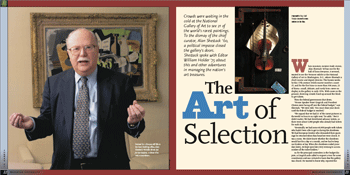The Art of Selection
 When museum curators trade stories, Alan Shestack ’60 has one for the hall of fame.Everyone, it seemed, wanted to see the Vermeer exhibit at the National Gallery of Art in Washington, D.C., where Shestack is chief curator and deputy director. The known works by this 17th–century Dutch master number a scant 35, and for the first time in more than 300 years, 21 of them—small, delicate, and rarely lent—were on display in the gallery in early 1996. With snow on the ground, shivering crowds lined up around the block to get tickets.
When museum curators trade stories, Alan Shestack ’60 has one for the hall of fame.Everyone, it seemed, wanted to see the Vermeer exhibit at the National Gallery of Art in Washington, D.C., where Shestack is chief curator and deputy director. The known works by this 17th–century Dutch master number a scant 35, and for the first time in more than 300 years, 21 of them—small, delicate, and rarely lent—were on display in the gallery in early 1996. With snow on the ground, shivering crowds lined up around the block to get tickets.
Then the federal government shut down.
“House Speaker Newt Gingrich and President Clinton were facing off over the federal budget,” says Shestack. “We were told, ?You must close your doors until the federal budget is resolved.’
“We argued that we had 21 of the rarest pictures in the world on loan to us right now,” he adds. “But it didn’t matter. We had distributed advance tickets, so there were about 5,000 people who already had tickets for each day.
“Eventually, we had some 40,000 people with tickets who hadn’t been able to get in during the shutdown. We had European lenders who demanded their paintings be returned when they heard we were closed. It was a mess. We didn’t know whether the shutdown would last for a day or a month, and we had to keep our lenders at bay. When the shutdown ended (nine days later), we kept open late every evening to accommodate all the ticket holders.”
As for the principal contenders in the budget dispute, a Gingrich aide called to request a tour for some constituents and was irritated to learn that the gallery was closed. He wanted to know why, reported the Tampa Tribune—a question that must have raised eyebrows among museum staff, though they are too discreet to comment on public figures.
President Clinton toured the exhibit before public hours, as is customary. Such visits are planned to avoid conflict with the public tours, but visitors on that particular cold morning, said the Washington Post, cooled their already chilled heels on the street for an extra half–hour while the president took his fill of Vermeer.
Shestack relishes telling this story in his elegant East Building office overlooking the U.S. Capitol building. Although he oversees 300 staff and 250 volunteers in a variety of museum functions, his passion is stewardship of the museum’s collection, a task he carries out with 28 curators. For a collection oriented toward great works of European and American art from the 15th century onward, acquiring art is becoming significantly more difficult.
“When I first started shopping for works of art in the early 1970s, I could go to London for a brief time and easily find several dozen desirable acquisitions, priced in a range between $100,000 and $1 million,” he relates. “Today, one can go to Europe for an extended stay, call on major painting dealers in the primary art market cities, and find only two or three works worthy of an important museum. And, of course, these few works will have multimillion dollar price tags.”
Other factors also constrain collecting, he notes. European nations have put in place export prohibitions to protect their cultural history. Many works of art in Italy or in English country houses, for instance, will never leave their country of origin.
Apportioning the gallery’s annual acquisition budget of about $8 million, all from endowment and private sources, is not easy. Fortunately for the collection, many works of art are donated, and curators spend considerable time cultivating the donors of these gifts.
Private collectors often have much larger sums of money available and can easily outbid museums for works of art that come to auction. Shestack wistfully recalls a German altarpiece from the early Renaissance that was auctioned at Christie’s a year or so ago. The gallery wanted to acquire it for no more than $2 million, but an art dealer bid it up to $3 million and is now asking $4 million as the sale price. With a twinkle in his eye, Shestack notes that it has not yet sold.
“There are certain fields in which we collect where the supply is still relatively abundant, but in other areas nearly everything already is in public hands,” Shestack says. “For instance, great Renaissance art rarely comes on the market and only at stratospheric prices, whereas Dutch 17th–century works are relatively plentiful. There were 1,800 Dutch painters in the 17th century churning out work.
“So the curator of Dutch paintings almost always has something good he can recommend, but the curators of Italian Renaissance or Northern European art rarely have anything we’d be able to buy.”
Shestack referees a competitive—and usually collegial— process in which curators make the best case for the acquisitions they favor. He brings a depth of experience honed by teaching 15 years at Yale and directing three museums—the Yale University Art Gallery, the Minneapolis Institute of Art, and the Boston Museum of Fine Arts.
“Early on, my mentor told me that I needed to become as familiar with paintings in the great European museums as I am with my wife’s handwriting,” he relates. “That’s the level of intimacy one needs with thousands of major artists active in Europe since the 15th century. That’s an ideal, but I worked at it. I spent two years abroad while I was working for my doctorate (at Harvard) memorizing for hours a day the collections in the National Gallery in London and the Alte Pinakothek in Munich, and more time at the British Museum print collection. I tried to learn the characteristic aging patterns for the paint of most schools, the brushstrokes, the condition of canvases, the frames.
“I came back feeling very confident that I could look at any European work of art and identify it—or at least come close!”
He returned to the United States and in 1965, at age 27, became curator of graphic art at the National Gallery, mounting exhibits such as Fifteenth–Century Engravings of Northern Europe, that reflected his academic specialty in northern European art. Five years later he became curator, then director of the Yale Art Gallery and adjunct professor of the history of art.
Part administrator and part scholar, Shestack has strong views about what museums should do, and should not do, to nourish the nation’s cultural life. High on his list of cultural misdemeanors is the transformation of viewing art from an aesthetic experience to a commercialized take–at–the–gate event. The blockbuster exhibit has become a major moneymaker for many museums, sometimes drawing hundreds of thousands of people and netting millions of dollars, as well as a windfall of publicity. Many museums are under pressure to get people in and out quickly, sell them a meal and a souvenir— in short, keep the money flowing in. With exasperation he recalls the time an influential individual demanded that the Boston Museum of Fine Arts host a Monet exhibit annually because it would be a sure money–maker!
The take at the gate is one issue he does not have to worry about at the National Gallery. Tickets to a popular show may be scarce, high government officials may receive special consideration, but admission is always free to everyone.
“A great blockbuster show is merely a cost to us,” he says. “We have to replace the paper towels in the restrooms more frequently. We have to put more visitor service and security staff on; we are protecting the property of others.”
“The cost of shipping and insurance is massive. Most lenders insist that their work of art be accompanied in transit by a courier at our expense. That courier oversees the loading on the airplane and the unloading, the unpacking, the installation, and might stay in Washington for five days at our expense. Some paintings arrive in special climate–controlled containers. We can have as many as 20 to 30 couriers for a given show, all housed in Washington hotels.”
He and his colleagues make educated guesses about which shows will attract the largest audiences, but they are often pleasantly or unpleasantly surprised, he acknowledges. Unlike permanent collections, exhibits cover the range of the art world—from the famous King Tut exhibit of 1977 that drew 835,924 visitors, to Art Noveau, which just closed after bringing in 260,000 people during its run of 14 weeks. (The staff guessed right about attendance at that one, Shestack reports.)
The best attended show of recent years was a 1997 exhibition devoted to the early years of Picasso. The 152 paintings, drawings, sketches and sculptures represented the first full survey of his early years, beginning at age 11. Approximately half a million people visited this show, as many as 4,500 per day.
“Some shows start off slowly but then word of mouth brings people in,” he says. “Word of mouth and press reviews are about equal in impact. Even a really bad review brings in people because many want to see what’s so horrible. The worst thing that can happen is a ho–hum review.”
The staff works on exhibits as far as five years in advance. At any time there may be 50 exhibitions in the pipeline, each creating its own issues ranging from the cajoling of loans to problems with foreign governments and embassies to the intricate work involved in producing a complex, book–length catalog. “It’s a massive undertaking,” he says, “and very polyphonic.”
The National Gallery won’t run out of opportunities to mount exhibitions, but Shestack is not so sanguine about the future of collecting. The great works of the European tradition are finite in number. Rembrandt, for instance, painted between 500 and 600 works in his lifetime, most of which by now have found their way into public collections. “One of my colleagues has predicted that in 10 years our collections of pre–20th– century art will become fixed for the rest of time,” he says. “I should add, however, that people have been saying this for 50 years and we’re still buying.”

